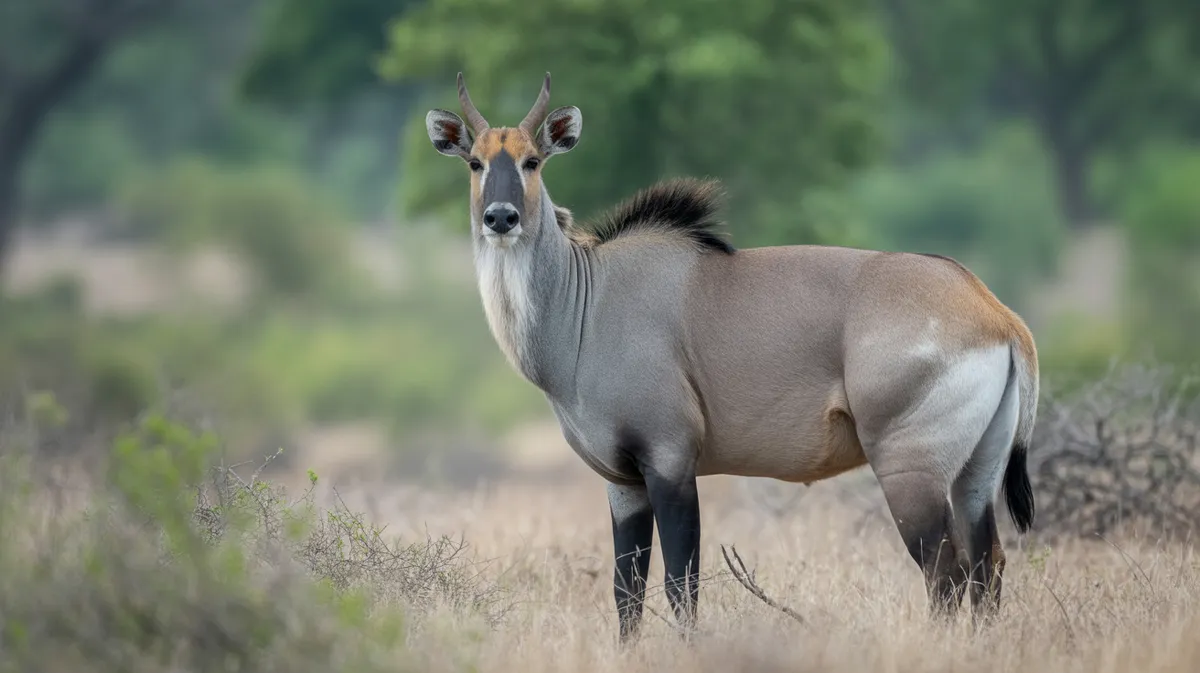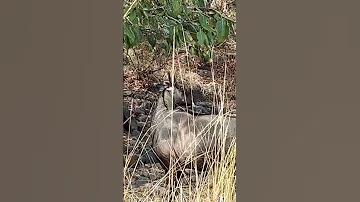
Nilgai
Boselaphus tragocamelus

Meet the Nilgai
The Nilgai, also known as the blue bull, is the largest Asian antelope, native primarily to the Indian subcontinent. Adult males display a striking bluish-grey coat, while females are tawny brown, and both sexes have white markings on the face and legs. Nilgai have robust, horse-like bodies with slender legs and a short, bristly mane. They are highly adaptable grazers and browsers, often found in grasslands and lightly wooded areas, and are well-known for their agility and speed. Despite their size, Nilgai are shy and elusive, often avoiding human presence.
Classification
Mammal
Habitat
Grassland, scrub forest, and lightly wooded areas
Diet
Herbivore
Lifespan
10-15 years
Conservation
Least Concern
Weight
120-240 kg
📖Fascinating Facts
Largest Asian Antelope
Nilgai are the biggest antelope species in Asia, with males weighing up to 240 kg.
Adaptable Diet
They feed on grasses, leaves, buds, and cultivated crops, making them very adaptable to different environments.
Distinct Sexual Dimorphism
Males are much larger than females and have a characteristic blue-grey color, while females are brown and lack horns.
📋Detailed Description
The nilgai (Boselaphus tragocamelus) is a robust, large-bodied antelope, with adult males standing 120–150 cm at the shoulder and weighing between 109–288 kg, while females are smaller at 100–213 kg. Males are easily distinguished by their slate-blue to steel-grey coats, while females and juveniles are a warm tawny or orange-brown. Both sexes have white facial markings, a prominent white throat patch, and white 'socks' on their lower legs. Only males possess short, conical horns (15–24 cm), which are slightly curved and lack rings. The nilgai's body is characterized by a sloping back, deep chest, and a distinctive mane along the neck, ending in a bristly tuft. A pendulous dewlap with coarse hair hangs from the throat, especially pronounced in males. Nilgai have acute senses of hearing and smell, aiding their vigilance in open habitats. Their limbs are long and slender, adapted for swift running, and their hooves are narrow, facilitating movement over hard ground. Socially, nilgai are typically found in small herds of 4–20, often segregated by sex outside the breeding season. They are crepuscular, most active at dawn and dusk, and are known for their shy, elusive nature despite their size.
💡 Did you know?
Nilgai are one of the few large wild herbivores that have successfully adapted to agricultural landscapes and sometimes become a pest to crops in India.
🔬Research & Sources
Wikipedia Summary
The nilgai is the largest antelope of Asia, and is ubiquitous across the northern Indian subcontinent. It is the sole member of the genus Boselaphus, which was first scientifically described by Peter Simon Pallas in 1766. The nilgai stands 1–1.5 m (3.3–4.9 ft) at the shoulder; males weigh 109–288 kg (240–635 lb), and the lighter females 100–213 kg (220–470 lb). A sturdy thin-legged antelope, the nilgai is characterised by a sloping back, a deep neck with a white patch on the throat, a short crest of hair along the neck terminating in a tuft, and white facial spots. A column of pendant coarse hair hangs from the dewlap ridge below the white patch. Sexual dimorphism is prominent – while females and juveniles are orange to tawny, adult males have a bluish-grey coat. Only males possess horns, 15–24 cm (5.9–9.4 in) long.
Last Modified: 5/28/2025
🎭Behavior & Social Structure
Nilgai are primarily diurnal to crepuscular, with peak activity during early morning and late afternoon. They are mixed feeders, exhibiting both grazing and browsing behavior, consuming a wide variety of grasses, leaves, buds, herbs, and agricultural crops. Nilgai are water-independent and can survive in arid regions by obtaining moisture from their food, though they will drink when water is available. Social structure is loosely organized; females and juveniles form herds, while adult males are often solitary or in small bachelor groups, joining female herds only during the rut. Nilgai are highly vigilant, using their keen senses to detect predators such as tigers, leopards, and feral dogs. When threatened, they flee with a distinctive, bounding gallop. Agonistic behavior among males includes displays such as neck wrestling and horn clashing, though serious injuries are rare. Nilgai communicate through visual signals, vocalizations (grunts, snorts), and scent marking via preorbital glands.
👶Reproduction & Life Cycle
Nilgai exhibit a polygynous mating system, with dominant males seeking access to receptive females during the rut, which typically peaks between November and February but may occur year-round in some regions. Courtship involves males following and guarding females, performing low grunts, and displaying their dewlap and mane. After successful mating, the gestation period lasts approximately 240–257 days (about 8 months). Females usually give birth to one or two calves, which are concealed in tall grass for the first few weeks of life. Calves are precocial, able to stand and walk within hours of birth. Maternal care is pronounced, with mothers nursing and protecting their young, while weaning occurs at 4–6 months. Sexual maturity is reached at 18–24 months for females and slightly later for males.
🛡️Adaptations & Survival
Nilgai are well-adapted to open, dry habitats, with their cryptic coloration providing camouflage in grasslands and scrub forests. Their long, slender legs and narrow hooves enable rapid running and efficient movement over hard, uneven terrain. The pendulous dewlap and short, bristly mane may aid in thermoregulation and visual signaling. Nilgai can subsist on a wide range of plant material, including tough, fibrous grasses and browse, reflecting a highly adaptable digestive system. Their ability to survive with minimal water is a key adaptation to semi-arid environments. Social flexibility, including the formation of loose herds and solitary behavior, allows them to exploit variable resources and avoid predation.
🎨Cultural Significance
The nilgai holds a unique place in South Asian culture and folklore. Its name, meaning 'blue cow' in Hindi, reflects its perceived kinship with domestic cattle, leading to protection in regions where cows are sacred. Nilgai are featured in ancient Indian art, literature, and mythology, sometimes symbolizing strength and resilience. However, their status as crop raiders has led to negative perceptions among farmers. In some communities, nilgai meat is consumed, and their hides are used for leather, though this is less common due to legal protections and cultural taboos. The species has also been introduced outside its native range, notably in Texas, where it is valued as a game animal.
🔬Recent Research & Discoveries
Recent research has focused on nilgai ecology in human-dominated landscapes, including their role as crop pests and their interactions with other wildlife. Genetic studies have clarified their evolutionary relationships within the tribe Boselaphini, confirming their status as the sole extant member of the genus Boselaphus. Studies on introduced populations in Texas have provided insights into their adaptability and ecological impacts outside their native range. Ongoing research addresses disease transmission (notably foot-and-mouth disease) between nilgai and livestock, and the effectiveness of non-lethal conflict mitigation strategies. Satellite telemetry and camera trapping are increasingly used to study their movement patterns, habitat use, and population dynamics.
🎥Wildlife Videos

The only recorded Leopard take-down of a Nilgai ever recorded! #wildlife #leopard
Catch the full documentary Leopard Dynasty - The Rise of Rana on ServusTV: ...
Terra Mater

Wildlife : Videography of Nilgai : Shooting of Nilgai in Nature #wildlife #nature #nilgai
Nilgai Blue Bull Antilope Nilgai Wild animals wildlife Hiran wildlife videography wildlife photography nature nature videography ...
Wildlife Experiences by Gaurav Bhardwaj

Asia’s largest antelope - Nilgai #ranthambore #wildlife #animals
Wonder Earth

Lion And Nilgai 😱 | #lion #nilgai #youtubeshorts #shorts #trendingshorts #viralvideo
Animal Shorts

Nilgai The Majestic Antelope's Journey #facts #reeflife #waterfall
Antelope Please like, share and Subscribe to Comrad Studios.
Comrad Studios

Wildlife: Fight of Nilgai : Survival of Nilgai in Nature #wildlife #nilgai #nature #wildanimals
Nilgai Fight Antilope Nilgai Wild animals wildlife Hiran wildlife videography wildlife photography nature nature videography nature ...
Wildlife Experiences by Gaurav Bhardwaj
🌍Habitat Information
The Nilgai typically inhabits Grassland, scrub forest, and lightly wooded areas environments. Nilgais have adapted to their environments with specialized features and behaviors.
Primary Habitat:
Grassland, scrub forest, and lightly wooded areas
More detailed habitat information will be available soon.
🛡️Conservation Status
The Nilgai is currently classified as Least Concern. Conservation efforts are crucial for preserving this species for future generations.
Common Threats:
- 🏠Habitat loss and fragmentation
- 🌡️Climate change impacts
- 🎯Hunting and poaching
- 🏭Human-wildlife conflict
⚠️Threats & Conservation Challenges
While the nilgai is currently classified as Least Concern by the IUCN, populations face several localized threats. Habitat loss and fragmentation due to agricultural expansion, urbanization, and infrastructure development reduce available range. Nilgai are often considered agricultural pests in India, leading to conflict with farmers and occasional culling. In some regions, illegal hunting for meat and hide persists. Natural predation by large carnivores has declined in many areas due to predator extirpation. Invasive populations, such as those introduced to Texas, USA, can impact local ecosystems. Despite these challenges, the nilgai's adaptability and tolerance of human-altered landscapes have allowed populations to remain stable or even increase in some areas.
🔬Scientific Classification
Scientific Name
Boselaphus tragocamelus
Classification Hierarchy
🔍 About Taxonomic Classification
Taxonomic classification is a hierarchical system used by scientists to classify and organize living organisms based on shared characteristics and evolutionary relationships.
The system moves from broad categories (Kingdom) to increasingly specific ones, with each animal's scientific name typically consisting of its Genus and species.
📝Community Notes
Share your observations and insights about the Nilgai with our community of wildlife enthusiasts.
Join Our Community
Sign in to share your observations and connect with fellow wildlife enthusiasts.
Sign In to ContributeNo community notes yet
Be the first to share your observations about the Nilgai!
Explore Nilgai
Select a tab above to learn more about this amazing animal.
📸Photo Gallery
No photos available for this animal yet.
🌟Discover More Wildlife
Continue your journey of discovery with more fascinating animals from our database
